Abstract
A synthetic nonapeptide fragment of thrombin inhibits the cellular motility in culture of a human melanoma subclone that possesses a high metastatic potential in mice. Concomitant with the loss of ability to translocate in culture, these cells exhibit increases in the average length of actin cables and cellular surface area in contact with the substratum. The spreading activity is observed at a nonapeptide concentration of 1 nM within 1 hr of exposure at 37 degrees C. Pretreatment of cells with this nonapeptide does not block signal transduction through plasma membrane receptors for the following growth or differentiation factors: alpha-melanotropin (alpha-melanocyte-stimulating hormone), nerve growth factor, and transforming growth factor type beta. Results of the present study suggest an approach to cancer chemotherapy in which naturally occurring peptides from two functionally orthogonal classes may be used to perform two complementary functions: inhibition of metastasis and induction of differentiation.
Full text
PDF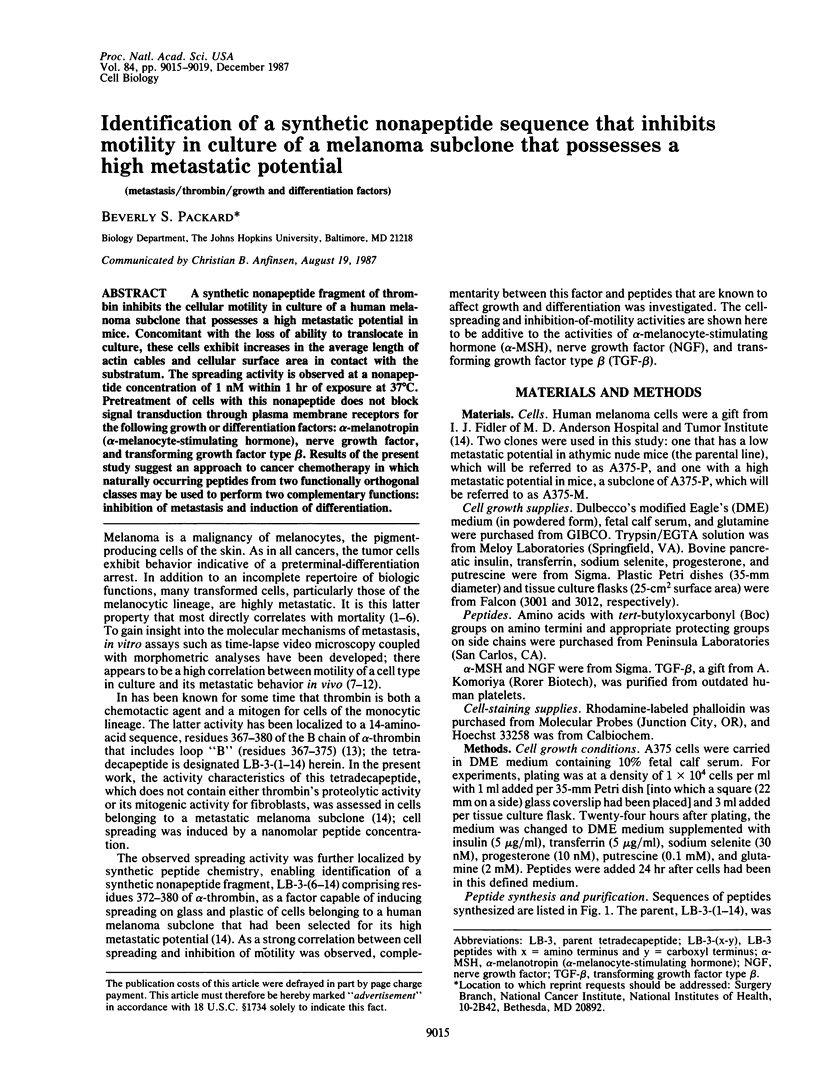
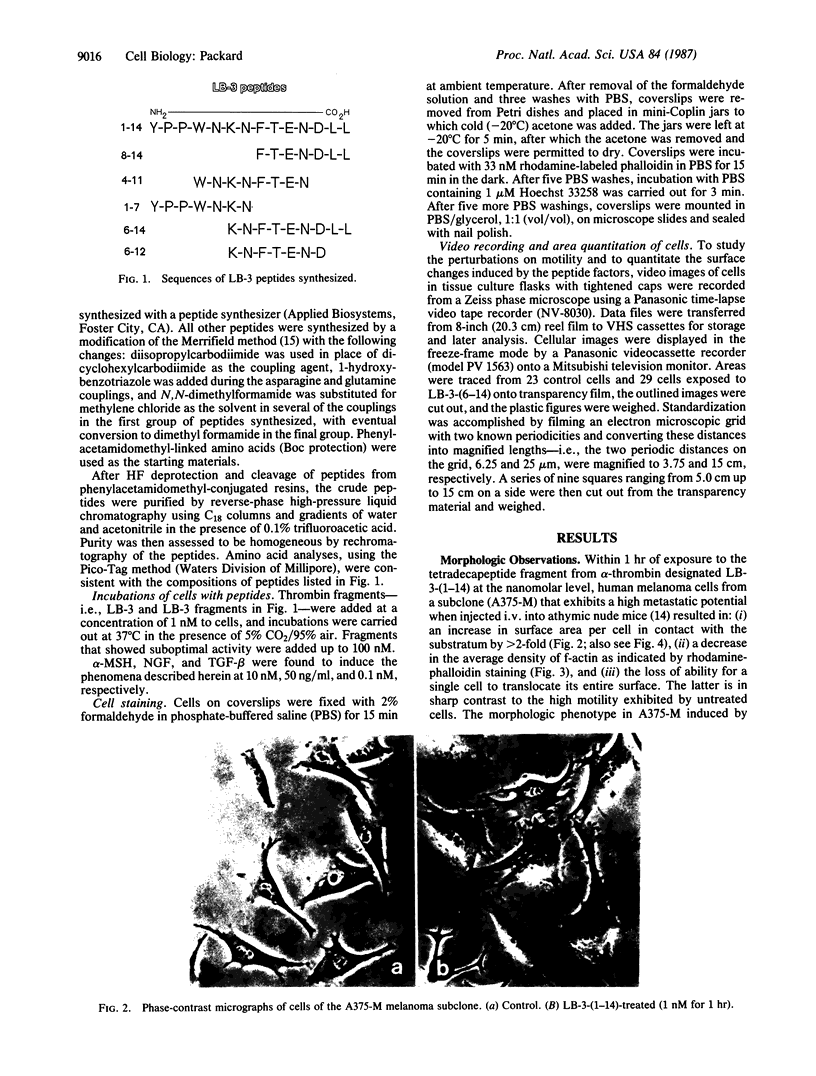
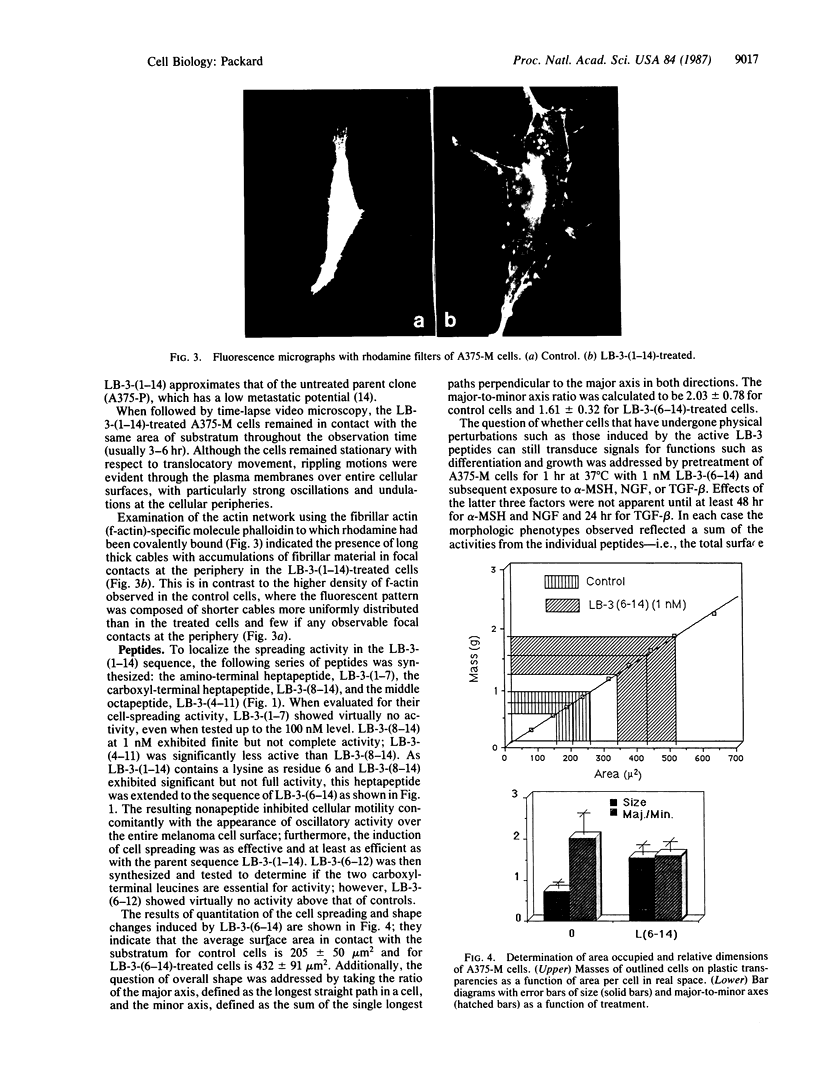
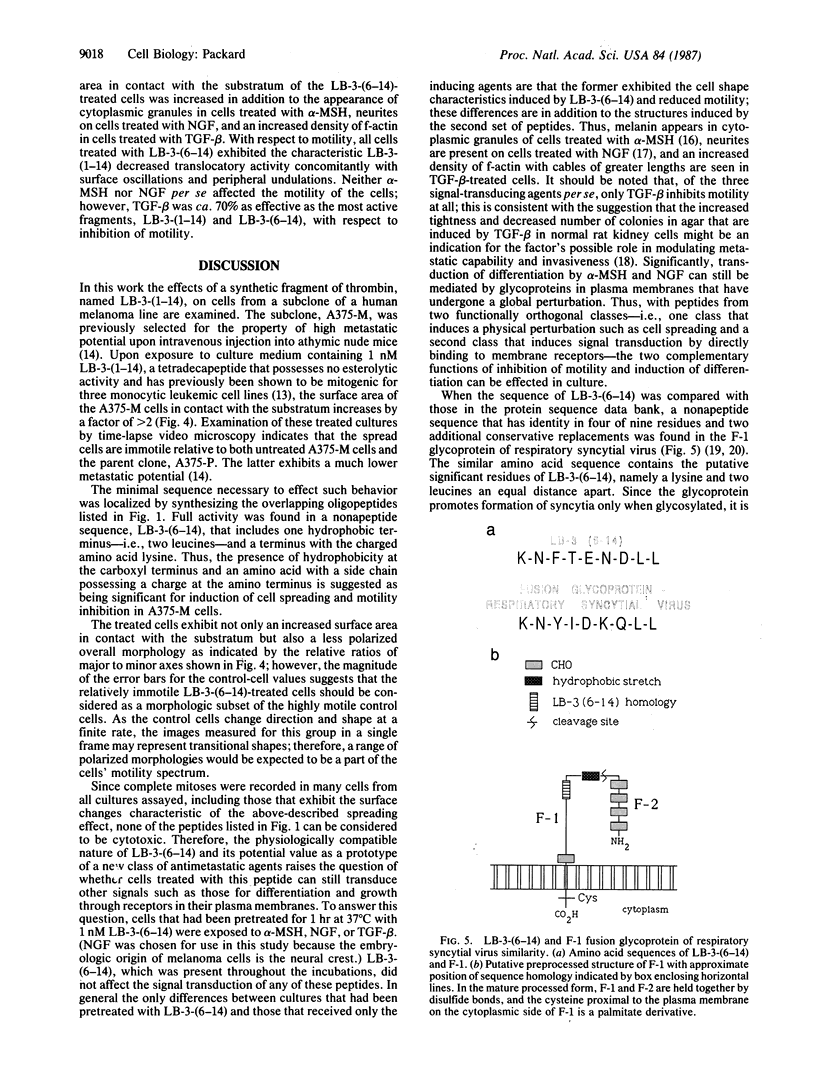
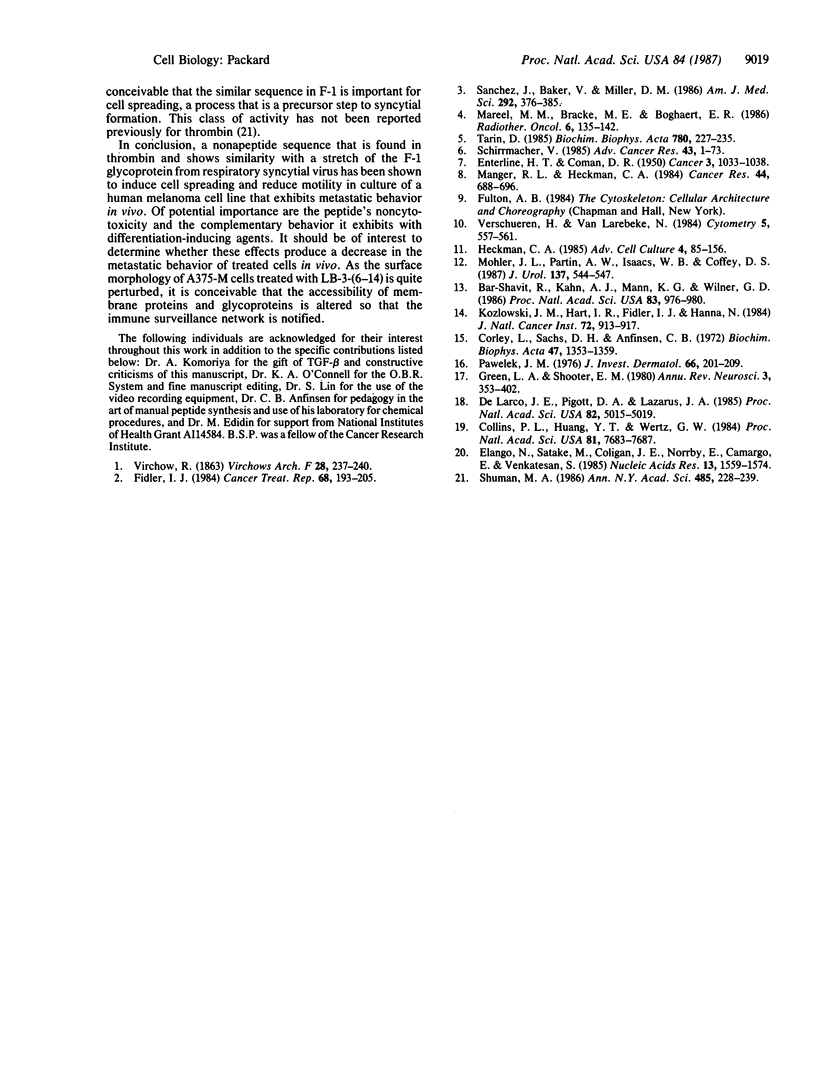
Images in this article
Selected References
These references are in PubMed. This may not be the complete list of references from this article.
- Bar-Shavit R., Kahn A. J., Mann K. G., Wilner G. D. Identification of a thrombin sequence with growth factor activity on macrophages. Proc Natl Acad Sci U S A. 1986 Feb;83(4):976–980. doi: 10.1073/pnas.83.4.976. [DOI] [PMC free article] [PubMed] [Google Scholar]
- Collins P. L., Huang Y. T., Wertz G. W. Nucleotide sequence of the gene encoding the fusion (F) glycoprotein of human respiratory syncytial virus. Proc Natl Acad Sci U S A. 1984 Dec;81(24):7683–7687. doi: 10.1073/pnas.81.24.7683. [DOI] [PMC free article] [PubMed] [Google Scholar]
- Corley L., Sachs D. H., Anfinsen C. B. Rapid solid-phase synthesis of bradykinin. Biochem Biophys Res Commun. 1972 Jun 28;47(6):1353–1359. doi: 10.1016/0006-291x(72)90221-5. [DOI] [PubMed] [Google Scholar]
- De Larco J. E., Pigott D. A., Lazarus J. A. Ectopic peptides released by a human melanoma cell line that modulate the transformed phenotype. Proc Natl Acad Sci U S A. 1985 Aug;82(15):5015–5019. doi: 10.1073/pnas.82.15.5015. [DOI] [PMC free article] [PubMed] [Google Scholar]
- ENTERLINE H. T., COMAN D. R. The ameboid motility of human and animal neoplastic cells. Cancer. 1950 Nov;3(6):1033–1038. doi: 10.1002/1097-0142(1950)3:6<1033::aid-cncr2820030612>3.0.co;2-r. [DOI] [PubMed] [Google Scholar]
- Elango N., Satake M., Coligan J. E., Norrby E., Camargo E., Venkatesan S. Respiratory syncytial virus fusion glycoprotein: nucleotide sequence of mRNA, identification of cleavage activation site and amino acid sequence of N-terminus of F1 subunit. Nucleic Acids Res. 1985 Mar 11;13(5):1559–1574. doi: 10.1093/nar/13.5.1559. [DOI] [PMC free article] [PubMed] [Google Scholar]
- Fidler I. J. Recent concepts of cancer metastasis and their implications for therapy. Cancer Treat Rep. 1984 Jan;68(1):193–198. [PubMed] [Google Scholar]
- Greene L. A., Shooter E. M. The nerve growth factor: biochemistry, synthesis, and mechanism of action. Annu Rev Neurosci. 1980;3:353–402. doi: 10.1146/annurev.ne.03.030180.002033. [DOI] [PubMed] [Google Scholar]
- Kozlowski J. M., Hart I. R., Fidler I. J., Hanna N. A human melanoma line heterogeneous with respect to metastatic capacity in athymic nude mice. J Natl Cancer Inst. 1984 Apr;72(4):913–917. [PubMed] [Google Scholar]
- Manger R. L., Heckman C. A. Behavioral anomalies of highly malignant respiratory tract epithelial cells. Cancer Res. 1984 Feb;44(2):688–696. [PubMed] [Google Scholar]
- Mareel M. M., Bracke M. E., Boghaert E. R. Tumour invasion and metastasis: therapeutic implications? Radiother Oncol. 1986 Jun;6(2):135–142. doi: 10.1016/s0167-8140(86)80020-2. [DOI] [PubMed] [Google Scholar]
- Mohler J. L., Partin A. W., Isaacs W. B., Coffey D. S. Time lapse videomicroscopic identification of Dunning R-3327 adenocarcinoma and normal rat prostate cells. J Urol. 1987 Mar;137(3):544–547. doi: 10.1016/s0022-5347(17)44103-6. [DOI] [PubMed] [Google Scholar]
- Pawelek J. M. Factors regulating growth and pigmentation of melanoma cells. J Invest Dermatol. 1976 Apr;66(4):201–209. doi: 10.1111/1523-1747.ep12482134. [DOI] [PubMed] [Google Scholar]
- Sanchez J., Baker V., Miller D. M. Basic mechanisms of metastasis. Am J Med Sci. 1986 Dec;292(6):376–385. doi: 10.1097/00000441-198612000-00008. [DOI] [PubMed] [Google Scholar]
- Schirrmacher V. Cancer metastasis: experimental approaches, theoretical concepts, and impacts for treatment strategies. Adv Cancer Res. 1985;43:1–73. doi: 10.1016/s0065-230x(08)60942-2. [DOI] [PubMed] [Google Scholar]
- Shuman M. A. Thrombin-cellular interactions. Ann N Y Acad Sci. 1986;485:228–239. doi: 10.1111/j.1749-6632.1986.tb34585.x. [DOI] [PubMed] [Google Scholar]
- Tarin D. Clinical and experimental studies on the biology of metastasis. Biochim Biophys Acta. 1985;780(3):227–235. doi: 10.1016/0304-419x(85)90005-8. [DOI] [PubMed] [Google Scholar]
- Verschueren H., Van Larebeke N. A new model for the quantitative analysis of cell movements in vitro: definition of a shape change factor. Cytometry. 1984 Nov;5(6):557–561. doi: 10.1002/cyto.990050602. [DOI] [PubMed] [Google Scholar]




